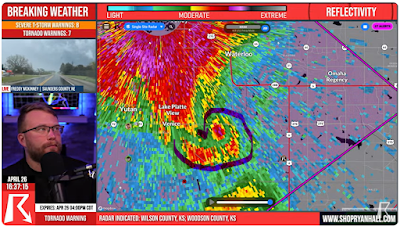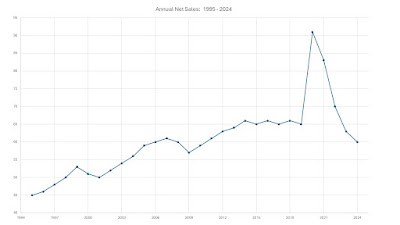Last week parts of the Country experienced three days of exceedingly severe weather (yes, this topic will eventually angle back to you).
If you spent your formative years in the 1980s and you liked weather, you were mesmerized by the concept of somebody broadcasting weather on cable television ... all day ... every day.
And eventually coverage evolved so that Jim Cantore could be filmed standing outside a hotel while a hurricane hit. Times change.
Several years ago Fox began broadcasting their own weather network. Viewers on other systems could watch the Weather Network ... so there's competition, sure.
And then, hiding in plain sight on YouTube, you have Ryan Hall. When there is a severe weather outbreak, more than a hundred thousand viewers will watch his twelve-hour live streams, paired with four or five or six storm chasers and actual meteorologists describing the physics of storms. It's a stimulating broadcast.
While this is happening, his viewers raise money for storm victims ... last week it was around a hundred thousand dollars a night ... certainly not enough to rebuild towns leveled by tornados but it is more than $0. He has a community, and the community rallies around bad situations.As you watch on YouTube, you can comment on the broadcast, and if your comments are reasonable, your comments will be mentioned on-air.
As of a few years ago, The Weather Channel might average 140,000 viewers, +/- ... undoubtedly that number goes up doing storms. So the fact that this guy had more than 100,000 viewers each night last week is saying something. Undoubtedly ... the demographic is very different as well.
Oh, he's got critics (click here). He's not a meteorologist, so the online folks with weather training tend to view his efforts negatively. Every one of us has experienced this form of criticism ... "You don't have a Masters Degree in Statistics ... you are not an Omnichannel Marketing expert ... you are not a good enough pickleball player to help others ... you don't have fashion merchandise training ... you are not a digital marketer so you don't know anything, you're old-fashioned".
Welcome to the modern world.
It's been estimated that Ryan Hall makes +/- $250,000 per year via his community ... YouTube puts ads in his programming and gives him a cut. I have no idea if the $250,000 per year figure is true or not, but he's got nearly 2,000,000 followers now so if that figure is remotely close to true he's earning maybe $0.12 per community member per year ... again, those are wild guesses designed to make you think.
Back to you and your business.
E-commerce evolved, and as I said eight years ago, e-commerce brands were going to become media brands. The e-commerce brand monetizes the world differently from media brands.
- Media Brands create content, content attracts viewers, viewers attract advertisers, advertisers pay Media Brands a toll for access to viewers. Media Brands ultimately depend on Advertisers, but without a community (viewers) there are no Advertisers.
- E-commerce Brands sell products, products attract a community, the community pays the E-commerce Brand by purchasing products. E-commerce Brands depend on Customers, and Customers are part of a Community.
Based on some of the work I've done this year, you need +/- 30 members of a well-developed community to generate one annual customer. Yes, this research is going to constantly change. So think about it this way ... if you created a community and had 100,000 registered users who actually cared about your community, you could theoretically generate 100,000/30 = 3,333 customers each year ... if a customer spent $200.00 a year, you'd have $666,600 in net sales. That would be $6.67 per community member.
If you do a great job, you might get 1 customer per 10 community members, maybe 1 customer per 7 community members. Heck, I have a community of over 10,000 followers between Blog/LinkedIn/Twitter, and anywhere between 15-40 clients per year. That's 1 customer per maybe 363 community members ... but my AOV is huge, so I can get away with a "low level of engagement".
I was never a big "community" marketing advocate ... I spoke at a conference more than a decade ago, and it was my job to poke holes in the community marketing model. That was 2011ish. By 2016, I could see the light. In 2024, you kind of have no choice. Worse, if you don't build out your own community, your customers will do it for you off-platform ... they'll talk about you on the socials, out of your control.
When I think about traditional catalog brands, I realize the catalog industry didn't focus on building communities. The "community" by default became the shared pool of 65+ year old customers who liked buying via catalogs, and a small number of data-centric brands collected the data from catalogers (who sent their own customer data to these brands at no cost - imagine the insanity of that sentence), mixed it up and re-sold it back to catalogers, which meant catalogers were constantly paying the data industry a toll for access to their own community. That's a bad business model for catalogers. That's a great business model for data brands.
One you have this realization (that traditional catalog brands were paying a toll to third parties for access to the community they built), you cannot unsee the unfairness of the situation. Yes, there were catalog executives who made horrible decisions in the 2000-2005 timeframe that led to the community being a toll-based community, but it doesn't have to stay that way. The future is yet to be written.
Now that you see it this way, you see that all of catalog marketing is a ridiculous toll-collecting process ... it's the opposite of community building.
- Pay a toll to co-ops.
- Pay a toll to your paper brand.
- Pay a toll to your printer.
- Pay a toll to the USPS.
- Pay a toll to your favorite consultancy who is now owned by your favorite paper brand.
And if you want to be viewed as a digital marketer to complement your old-school efforts, it's just as bad.
- Pay a toll to Shopify.
- Pay a toll to your Search Vendor.
- Pay a toll to your Email Vendor.
- Pay a toll to your Retargeting Vendor.
- Pay a toll to Google.
- Pay a toll to Facebook.
- Pay a toll to an Influencer.
Do you see it?
You can't unsee it once you see it.
Google/Facebook are simply "communities at scale", and all of us are paying them tolls for access to our own customers ... customers that we lazily didn't adhere to our brands because our community building efforts failed miserably (or were never initiated in the first place).
You're going to have to build out your own community, going forward. Why are we constantly paying tolls?
The toll collectors will be angry. They'll tell you that you are stupid (how can you avoid Facebook, all of your customers are there?).
Part of becoming a Media Brand is crafting a community that others pay you for access to. For e-commerce, you don't need to give anybody access to your community ... the community will pay you for access to what you sell.
Every week, somebody contacts me asking to pay me for access to you. You are my community, and they don't want to do the hard work of building their own community ... they want to pay me a toll instead. Lazy marketers, every one of them.
You're going to have to do the hard work of building your own community. That way, when the toll collectors charge you 15% more for the same access next year, you can ignore them.
You are a media brand. How well-developed is your community?
Send me an email (kevinh@minethatdata.com) with your thoughts.

























